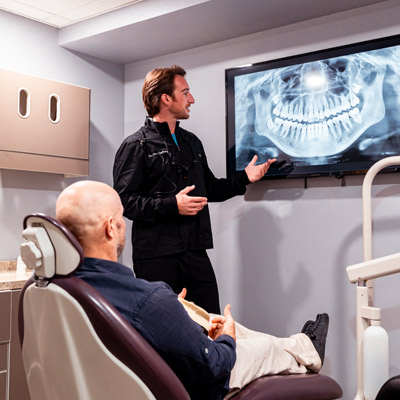Dental X-rays
 One of the most important diagnostic tools we use at Starboard Dental is dental X-rays. During your visit to our office you may hear us use words such as radiography and radiograph. A radiograph, often called an X-ray, is the image taken. Radiography is the technique used to obtain the radiograph.
One of the most important diagnostic tools we use at Starboard Dental is dental X-rays. During your visit to our office you may hear us use words such as radiography and radiograph. A radiograph, often called an X-ray, is the image taken. Radiography is the technique used to obtain the radiograph.
Your individual schedule for routine radiographs will depend on a number of factors including age, prior history, and certain dental conditions. If you can’t remember the last time you had X-rays taken, it’s probably time to give us a call to determine whether you’re due (or long overdue!) for a new set.
Why Dental X-rays Are Necessary
We are only able to see so much of your teeth and gums from a thorough visual examination. To aid in the detection and diagnosis of dental conditions such as decay between teeth and under existing restorations, gum disease, bone infections, abscesses, growth abnormalities, and even tumors, we rely on the use of up-to-date X-ray images.
When we can identify these types of problems in their early stages, we can save you pain, discomfort, money and extended care in our office. Discovering serious conditions, such as tumors, may very well save your life, so the small amount of radiation that you are exposed to during the X-ray process is minimal when compared to the benefits of having them taken!
Types of Dental X-Rays
There are a number of traditional dental X-rays that are taken inside the mouth. They include:
- Bitewing X-rays (BWX) – this type of x-ray is taken to show the crown (tooth surface above the gum) of both upper and lower teeth when biting together. Bitewing x-rays are useful for identifying cavities between teeth. Typically, they are taken during routine cleaning appointments and are updated every twelve months.
- Periapical X-rays (PA) – this type of x-ray is taken to show the entire tooth from crown to root tip. Periapical x-rays help detect abscesses, bone loss, gum disease, impacted teeth and other tooth or bone abnormalities.
- Full Mouth Series (FMX) – this type of x-ray is taken to show your provider a complete picture of your teeth as well as your jaw bones and gums. A Full Mouth Series helps to monitor your oral health as well as detect and diagnose any dental conditions. These x-rays are typically taken at your New Patient Examination and are updated every 3-5 years.
- Occlusal X-rays – this type of x-ray is taken to show the floor and roof of the mouth and are taken from a position looking down from the nose or up from the chin. They are used to locate additional teeth or teeth that have not yet erupted, abscesses, jaw fractures, or various types of growths, such as cysts.
What Do Radiographs Mean to Me as a Patient?
Radiographs serve as the starting point for a detailed dental treatment plan to address any of the issues indicated by the radiographs. They are an important diagnostic tool designed to identify conditions that, if left untreated, can cause a great deal of pain and money – neither of which is pleasant!
We recommend that you call us to determine whether it is time to schedule a routine dental care visit, which would include any necessary X-rays. At Starboard Dental, we care about your dental health.
CONTACT US

